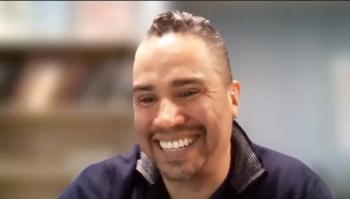
Oncology NEWS International
- Oncology NEWS International Vol 17 No 9
- Volume 17
- Issue 9
New paradigm in pancreatic cancer promotes coordinated patient care
Between YouTube and MySpace, it doesn’t take much to become an Internet sensation. But Randy Pausch, PhD, may have been one of the few Web stars who deserved the attention.
ABSTRACT: Experts agree that a multidisciplinary approach offers an unparalleled level of patient care, but differ on the best way to bring specialists together to treat a notoriously difficult disease.
Between YouTube and MySpace, it doesn’t take much to become an Internet sensation. But Randy Pausch, PhD, may have been one of the few Web stars who deserved the attention.
In 2006, Dr. Pausch, a computer science professor at Carnegie Mellon University in Pittsburgh, was diagnosed with pancreatic cancer. His 2007 “last lecture” focused on the achievement of his dreams, rather than his impending death, and was viewed by millions online. A book based on the talk leapt to the top of the bestseller list.
Before his death 2 months ago, Dr. Pausch lobbied for more funding for pancreatic research, a disease that has historically offered patients terrible odds: The 1-year survival rate for metastatic pancreatic cancer is only 26%, while the 5-year survival rate is 5%, according to the American Cancer Society. Even in localized disease, the 5-year survival rate is 20%. Rapid metastases and difficult surgical removal are two of the main reasons survival rates are so dismal.
When a disease is notoriously difficult to treat, consensus on how to manage these patients can be elusive. Two U.S. institutions believe the trick to coordinating and improving patient care lies in a multidisciplinary approach. While a marriage of multiple specialists sounds worthwhile, however, it may be as tricky to contend with as the pancreatic cancer itself. ONI spoke with experts on the pros and cons of establishing dedicated pancreatic cancer teams.
Coordinated care
Single-site, single-day multidisciplinary clinics for pancreatic cancer are uncommon. Proponents
say these clinics offer significant benefits for patients, including easier access to care and improved staging and treatment.
A recent study by a team at Johns Hopkins Hospital in Baltimore demonstrated improved outcomes for pancreatic cancer patients seen in a dedicated clinic.
“With a multidisciplinary clinic and conference, the review of patient data is so much more comprehensive,” said study leader Joseph Herman, MD, assistant professor of radiation oncology at the hospital.
The pancreatic multidisciplinary clinic brought together medical and surgical oncologists, pathologists, radiologists, and radiation oncologists at the Sol Goldman Pancreatic Cancer Research Center to review the cases of 203 patients referred to Johns Hopkins from outside institutions.
The clinic reviewed routine blood work and 3D CT studies, as well as physical exam and patient history as provided by support services and other hospital staff. The group analysis prompted changes in staging of disease in 19% of patients and new treatment recommendations in 24%.
With the initiation of the clinic, patient enrollment into the National Familial Pancreas Tumor Registry increased from 49.2% to 77.8% over a 2-year period, according to the authors (Ann Surg Oncol 8:2081-2088, 2008).
“Little things that are ordinarily missed were not missed because of the coordination of care by different specialists. It also provided reassurance for patients-they could be seen by different specialists in one trip, which helped ease their anxiety,” Dr. Herman said.
Finally, the clinic served as an educational tool for young physicians and improved communication among the different disciplines at the hospital, he added.
At St. Vincent’s Hospital in New York City, the Pancreas and Biliary Center was recently opened as a “one-stop shopping” resource center. Patients have access to specialists, diagnostic tests, and support services in one location, said Franklin Kasmin, MD, the center’s medical director for endoscopic ultrasound.
At the center, patients are seen for an initial evaluation by a hepatobiliary surgeon, specializing in pancreatic cancer, and a gastrointestinal biliary specialist. After biopsy, a clinical oncologist evaluates the patient on the same or next day. All cases are reviewed in regular multidisciplinary conferences.
“The therapy of pancreatic cancer is a race against time. Coordinated care helps us achieve rapid and appropriate treatment and also eases patients’ anxiety and fear,” Dr. Kasmin said. Because specialists are available in one space, diagnosis and plans for treatment take less time, and patient questions can be more easily and quickly answered, he said.
Ideal but inefficient
Setting up a dedicated pancreatic clinic requires significant financial investment, however, not to mention staff. Even for the most comprehensive cancer center, a niche clinic is a tall order.
“It is just not efficient for all our specialists to be at the same place at the same time in a multidisciplinary clinic,” said John Marshall, MD, director of gastrointestinal oncology at Georgetown University’s Lombardi Cancer Center in Washington, DC.
Patient throughput is one major obstacle: A single specialist can fit more patients into his or her day than can a multidisciplinary team, which may only see only five patients in half a day, Dr. Marshall said.
Logistical challenges
Steven Cohen, MD, associate medical director at Fox Chase Cancer Center Partners, concurred that holding a formal multidisciplinary clinic poses a logistical challenge.
“Half our patients have distant metastases and need to be seen by a medical oncologist. There’s not a role for the radiation or surgical oncologist. Others need to have gastrointestinal procedures that can’t be accomplished the same day as the initial visit,” Dr. Cohen said.
Instead, a multidisciplinary gastrointestinal cancer conference is held twice a month at Fox Chase, serving to enhance communication among all specialists and refine diagnoses and treatment, according to Dr. Cohen.
At Lombardi, a pancreatic cancer coordinator also oversees patient entry. While day-to-day patient management falls to the medical oncologist, all pancreatic cancer specialists keep in touch via e-mail in what Dr. Marshall called “a virtual multidisciplinary clinic.” While the e-mail exchange is casual, all cases are reviewed at a weekly in-person conference.
The conference can settle discrepancies in care, Dr. Marshall said. For instance, adjunct therapy, and radiotherapy in particular, in pancreatic cancer patients remains controversial. The conferences allow for different opinions to be aired, he said.
“In a multidisciplinary conference, we can consider the best advice of all specialists and the most current knowledge and work together as caregivers to provide the best outcomes for patients,” Dr. Marshall said.
Enhancing cross-talk
Even without the creation of a full clinic, multidisciplinary care can be implemented, according to
Douglas Evans, MD, at M.D. Anderson Cancer Center (MDACC) in Houston. Dr. Evans and his colleagues wrote an editorial on the multispecialty model discussed by Dr. Herman’s group.
Dr. Evans suggested that there are other ways to achieve the same goal as a dedicated clinic without the expenditure. These include the creation of outpatient centers that are disease-specific rather than specialty-specific, weekly multidisciplinary conferences; or arrangement of office space by disease orientation rather than standard hospital department configuration (Ann Surg Oncol 8:2078-2080, 2008).
Dr. Evans, a surgical oncologist, told ONI that M.D. Anderson converted from a department-centered facility to multiple disease-specific site centers (
“It was a tremendous advantage in terms of coordinating patient care,” he said. “But it was a huge undertaking in terms of space allocation.” Fortuitously, M.D. Anderson was already undergoing an expansion so the change was achievable, he added.
As with the clinics, the pancreatic cancer specialists at M.D. Anderson gather on a weekly basis to discuss particularly complicated cases (see Table). “With so many specialists present, it’s very unlikely we’ll see a situation that we haven’t run into before,” Dr. Evans said.
Regardless of whether a clinic functions on a large or small scale, all of the physicians agreed that multidisciplinary care offers an unparalleled educational opportunity for current and future pancreatic cancer care specialists. As long as the group dynamics are right, a multispecialty team can be “fun, academically stimulating, and self-perpetuating,” the M.D. Anderson group wrote.
“The multidisciplinary review/interaction…enhances cross-talk between specialties and allows for the development of consensus regarding stage-specific (and to some degree institution-specific) treatment algorithms,” the authors noted.
Advocacy network looks to raise pancreatic ca profile
The Pancreatic Cancer Action Network (PanCAN) was launched in the 1990s by primary founder Pamela Acosta Marquardt (who lost her mother to pancreatic cancer in 1996) and a small group of volunteers. Less than a decade later, PanCAN has become the leading voice for pancreatic cancer patients, working to increase awareness among government officials and the public.
“One of the biggest challenges we face is that funding for pancreatic cancer research has lagged behind that for other diseases,” said Julie Fleshman, president and CEO. “We have no early detection, little understanding of the basic biology, and limited treatment options, yet pancreatic cancer research is extremely underfunded.”
PanCAN’s profile did receive a boost in the public eye after actor Patrick Swayze was diagnosed with pancreatic cancer, said Michelle Duff, director of research and scientific affairs. When Swayze’s condition was revealed in April, the gossip rags gave him mere weeks to live. Months later, Swayze continues to undergo treatment at Stanford University while shooting a new TV series set to debut on the A&E network in the fall.
One of PanCAN’s trademark programs is Patient and Liaison Services (PALS), through which doctors, patients, and caregivers can search for clinical trials for their patients and obtain free educational information.
PanCAN (
“As well as reaching out to patients, one of our goals is to increase the dollars available for research. Then, we believe, we’ll start to see more progress in detection and treatment of pancreatic cancer, so that patients can live longer,” Ms. Fleshman said.
Articles in this issue
over 17 years ago
Japanese team discovers more cancer falloutover 17 years ago
Panel pans FDG-PET for new Medicare oncology coverageover 17 years ago
Sen. Kennedy's brain tumor puts spotlight on new treatmentover 17 years ago
Precise resection in colon cancer may boost survivalover 17 years ago
Payer’s budget to get right targeted drug to right patientover 17 years ago
PET brings treatment changes in majority of colon ca casesover 17 years ago
High death rate brings prostate ca vaccine trial to a haltover 17 years ago
Radiofrequency ablation eliminates nondysplastic BEover 17 years ago
Childhood cancer research gets $30 million from fedsNewsletter
Stay up to date on recent advances in the multidisciplinary approach to cancer.















































































